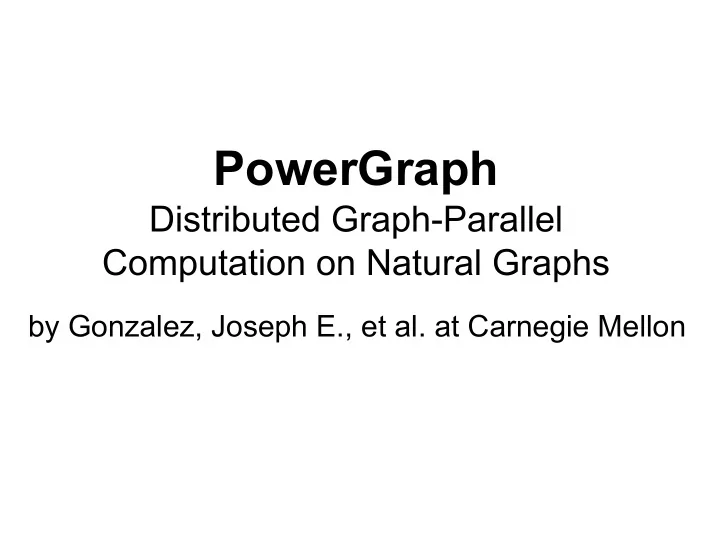

PowerGraph Distributed Graph-Parallel Computation on Natural Graphs by Gonzalez, Joseph E., et al. at Carnegie Mellon
What is PowerGraph? ● A graph-parallel system that is a distributed version of GraphLab ● Defines program in terms of gather, apply, sum and scatter operations. ● Attempts to handle natural graph problems more efficiently than predecessors (Pregel)
A PowerGraph program
Why do we care about natural graphs?
Why do we care about natural graphs? ● They are natural - we want to work with real world phenomenons ● They often have skewed power-law distributions ● Probability of degree d, P(d) = d -α
Challenges of Natural Graphs ● Work Balance ● Partitioning ● Communication ● Storage
How is efficiency obtained with PowerGraph? ● Edge-based distribution of work ● Delta caching ● Asynchronous relaxations ● Greedy vertex cutting / allocation
How is efficiency obtained with PowerGraph? ● Edge-based distribution of work ● Delta caching ● Asynchronous relaxations ● Greedy vertex cutting / allocation
What happens when we can’t fit all edges of a vertex on one machine?
What happens when we can’t fit all edges of a vertex on one machine? Answer: Vertex Mirroring! ● Data mirrored for locality to all nodes ● Apply function only performed on the master nodes
Placement of edges Let A(v) be the set of machines containing the adjacent edges of vertex v. For each edge (u,v): 1. If A(u) ∩ A(v) ≠ ∅ , assign edge to a machine in the intersection. 2. If A(u) ∩ A(v) = ∅ and A(u)≠ ∅ or A(v) ≠ ∅ : Assign edge to the machine of the vertex with the most unassigned edges 3. If only one of the two vertices has been assigned, assign the edge to a machine from the assigned vertex. 4. If neither vertex has been assigned, then assign the edge to the least loaded machine.
Placement and fault tolerance Placement is done either w.r.t local or global state ● Tradeoff between load-time and algorithm run-time Fault tolerance ● Snapshots are made after each “super-step” i.e. one gather-sum-apply-scatter step
Asynchronicity ● Allows for quicker execution as lock-step barriers are relaxed ● Satisfies sequential consistency and grants exclusive access to arguments ● Attempts to be fair to high degree vertices ● Allows for more rapid convergence for some algorithms
Results - Work Imbalance
Results - Communication
Results - Runtime
Criticism ● Much focus on performance but unfair comparisons for Pregel ● No graphs displaying performance comparisons between synchronous and asynchronous runtimes
Questions?
Recommend
More recommend